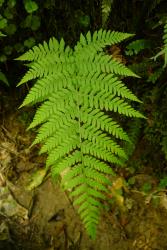- = Lunathyrium Koidz., Acta Phytotax. Geobot. 1: 30 (1932)
- = Athyriopsis Ching, Acta Phytotax. Sin. 9: 63 (1964)
Terrestrial ferns. Rhizomes creeping (NZ) or erect (not NZ), scaly. Rhizome scales non-clathrate, narrowly ovate or ovate. Stipes adaxially grooved, scaly and hairy. Laminae 1-pinnate-pinnatifid to 1‑pinnate-bipinnatifid (NZ) or entire to 3-pinnate (not NZ), herbaceous, scaly and hairy, groove of rachis U-shaped and not continuous with grooves of pinna midribs. Veins free. Sori elongated along veins and either single or paired on a vein (NZ) or rarely round or bent across the vein at one end (not NZ), indusia same shape as the sori, opening away from the vein, margins toothed or laciniate. Spores monolete, perispores echinate.
A genus of c. 70 species (PPG 1 2016). Deparia and allied genera in Japan were more clearly defined by Kato (1977), and subsequently Deparia was revised in the Pacific region (Kato 1984). Several genera that had been recognised earlier were reduced to sections within Deparia, including Lunathyrium and Athyriopsis.
Allan (1961) had earlier misidentified the sole New Zealand species as Athyrium japonicum (Thunb.) Copel. which, as Deparia japonica (Thunb.) M.Kato, is now known to be confined to the Himalayas, China, Korea, and Japan (Kato 1984).
Kuo et al. (2016, 2018) investigated over 80% of the species in Deparia using both morphological characters and analysis of four chloroplast DNA regions. They identified seven major clades that could be characterised morphologically. New Zealand plants of D. petersenii fell within the AT clade, roughly approximating to the previously recognised genus Athyriopsis. The lineage is characterised by creeping rhizomes, toothed indusial margins, and usually by auricled basal pinnae (although not in D. petersenii).
In New Zealand, Deparia can be recognised by the 1-pinnate-pinnatifid to 1-pinnate-bipinnatifid fronds bearing both hairs and scales, the presence of a U-shaped groove on the adaxial surface of the rachis that is not continuous with the grooves of the pinna costae, sori that are linear and arranged singly or paired back-to-back, and echinate spores (Large & Braggins 1991).
Distributed in tropical and warm-temperate parts of the Old World from tropical Africa through Asia, Australasia, and the Pacific Islands to Hawai‘i and North America (Kato 1984), with the greatest diversity in Asia; four species native to Africa and Madagascar (Roux 2009), 53 species in China (Wang et al. 2013), one in Australia (Jones 1998), about five in the south Pacific (Kato 1984), four indigenous to Hawai‘i (Palmer 2003), and one in North America (Smith 1993). One species in New Zealand of uncertain biostatus.
| Category | Number |
|---|---|
| Indigenous (Non-endemic) | 1 |
| Total | 1 |
The base chromosome number in Deparia is x = 40 or rarely 41 (Kramer 1990).




